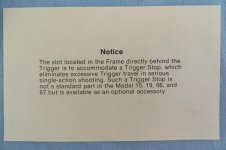I'm going to try to stay in my lane here. If you remove the side-plate of the revolver, you will see that the trigger stop is held in place with a small screw. The stop is not perfectly round. By loosening the screw and rotating the stop it is possible to have the rear of the trigger contact the forward-most portion of the stop at a point where the trigger "breaks" but travels beyond that point very little.
You are correct as relates to removal of this stop. Back when dinosaurs roamed the earth and police officers carried revolvers, I recall reading in law enforcement periodicals of the time that some agencies opted to take delivery without this stop or had armorers remove same fearing that the stop might become loose and prohibit full rearward trigger travel with attendant inability to fire the weapon. To be fair, I never heard of this happening but it nonetheless was a concern.
Someone more well versed in this subject will be along shortly to add to this.
HTH.
JPJ.


